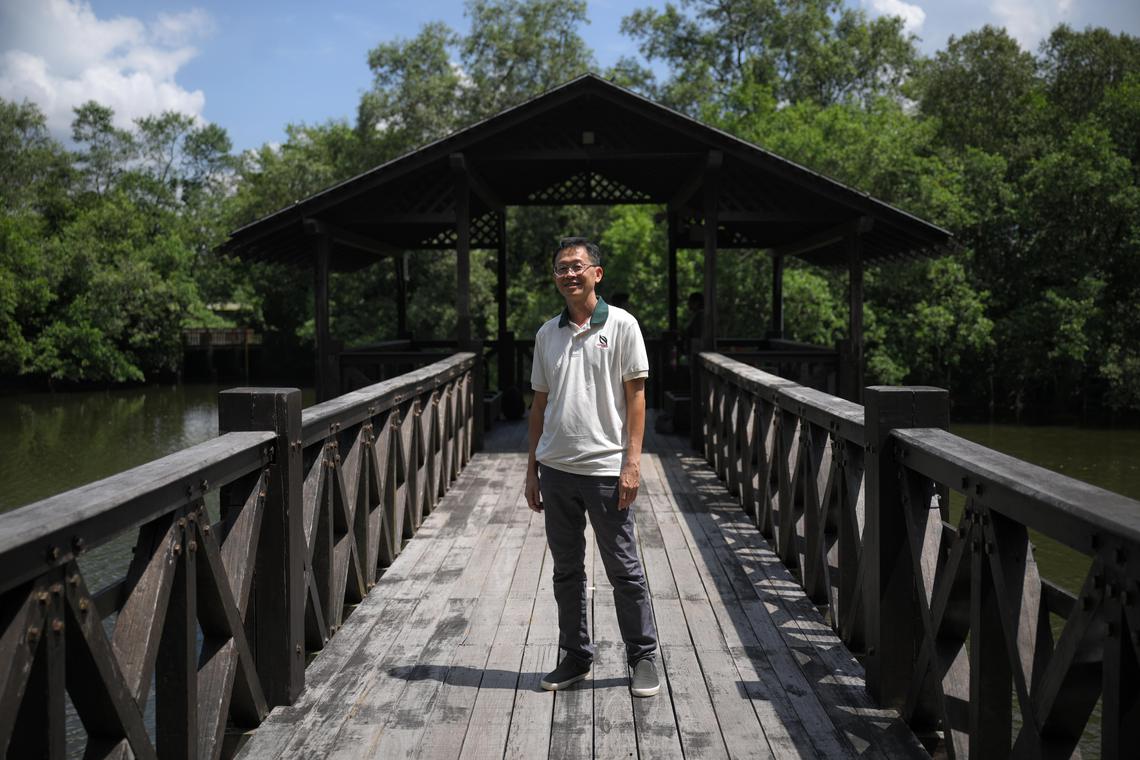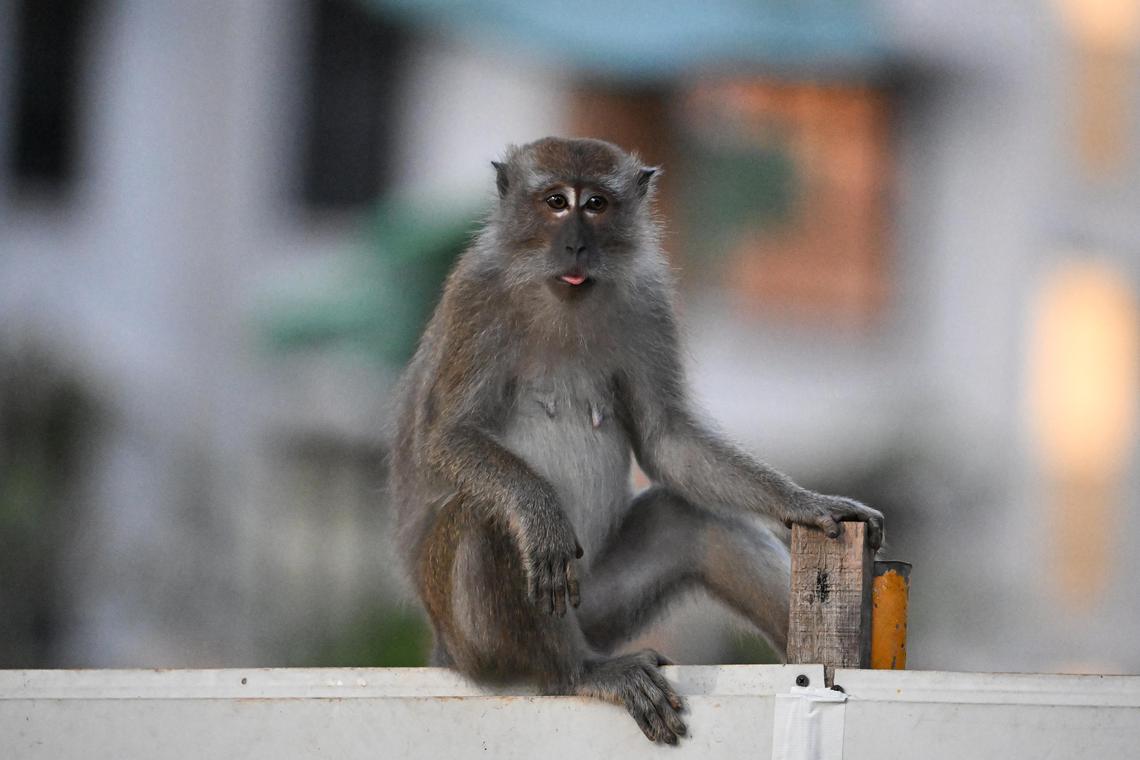July 1, 2025
SINGAPORE – In 2013, 570 monkeys – a third of the population then – were culled amid rising complaints by residents who were plagued by the animals in the Bukit Timah and MacRitchie estates.
Since 2023, the authorities have introduced a more humane approach to tackling the growing population of monkeys in the newer Punggol estates – by sterilising most of the 50 that were trapped. The rest were culled as they were deemed aggressive.
Singapore’s approach towards human-wildlife clashes has evolved greatly, from shooting stray dogs and crows in the past to putting in new measures like sterilisation and sonar repellers – with culling as a last resort in most cases now.
“Rather than being reactive after every conflict, we are identifying and addressing the extent of the issue and their root causes to take a longer-term solution instead of quick fixes,” Mr How Choon Beng, National Parks Board (NParks) group director of wildlife management, told The Straits Times.
Culling as a last resort
Mr How’s department typically steps in under three key circumstances involving wildlife: when their welfare is at stake due to injuries, when invasive fauna like crows affect the ecosystem, and when wildlife poses challenges to residents or endangers public safety.
Rather than focusing solely on removing the animals, it is looking at solving problems more holistically by tapping scientific approaches and engaging the community.
“We don’t want to take the easy way out… and cull, so we want to make sure that we try everything. If there are feasible methods, we will try (them),” Mr How said.
However, there are some instances when culling becomes necessary, such as when addressing wild boar attacks and large flocks of pigeons.
About a decade ago, there was a wild boar population explosion due to the absence of natural predators here and their high reproductive rate. As these animals ventured into newly developed estates and nature parks in the north, a slew of boar attacks followed. By 2023, there had been 28 reported incidents over a span of four years.
At the same time, the ecosystem was also affected as the foraging mammals are known to dig up soil, which can damage tree saplings and compromise reforestation. Wild boars can produce litters of up to 12 piglets, twice a year.

A wild boar in Lorong Halus on Jan 12, 2021. About a decade ago, there was a wild boar population explosion in Singapore due to the absence of natural predators here and their high reproductive rate. PHOTO: THE STRAITS TIMES
Fences and cattle grids were set up to keep boars within nature areas, away from housing estates, as the animals posed an immediate danger to the public and their population needed to be managed, Mr How said. Cattle grids are grates designed with gaps too wide for boars to cross without having their hooves caught. They do not obstruct access for park users and cyclists.
Between 2019 and mid-2023, around 50 boars were culled by NParks within Zhenghua Nature Park in Bukit Panjang.
Mr How explained: “Sometimes, we have to make decisions that may not be popular, but we know it is the right and necessary thing to do. We told the team that if we don’t cull 10 now, we have to cull 100 boars next time.”
In 2023, a natural tragedy struck Singapore’s wild boars when the African swine fever reached the country.
While it was reported that 18 boars succumbed to the disease in early 2023, the total death rate was expected to be higher.
Large flocks of pigeons also end up being culled because their droppings lead to hygiene issues and inconvenience to people.
Existing measures that solve the root problem of high pigeon numbers – from deterring feeding to covering tray return racks at hawker centres – take time to show results, said Mr How.
Culling is hence needed in the near term when the number of pigeons in a particular area needs to be quickly brought down, he added.
Science saves lives
From trawling through scientific papers to consulting other countries, and even placing trackers on crows, there is quite a bit of science that goes into finding ways to manage human-wildlife clashes.
The idea of sterilising monkeys has been a consideration for the NParks wildlife management team for a while, and Hong Kong implemented this as early as 2007. This option was also discussed with Singapore’s Long-tailed Macaque Working Group.
In Punggol, ground surveys in 2023 showed that the macaque population was increasing.
To establish the optimal sterilisation rates, the authorities began by conducting a population projection of the macaques, factoring in things like their reproduction and natural mortality rates.
“These projections will need to be continuously verified through ground surveys to ensure sterilisation remains effective in balancing the population numbers,” said Mr How.

Mr How Choon Beng, group director of wildlife management at NParks, at Sungei Buloh Wetland Reserve on June 13, 2025. PHOTO: THE STRAITS TIMES
For crows, fieldwork has been done to monitor their behaviour and to test solutions.
To better understand how crows would respond to the pruning of trees, Mr How’s team attached trackers to crows as part of a study that started in 2022.
As the study is ongoing, NParks said it is unable to provide further details.
Recently, through a 2008 scientific paper, it found that the deployment of plastic crow decoys in the US, or effigies, was effective in dispersing large numbers of house crows at large roost sites.
This finding led to NParks’ recent trial of the deployment of plastic crow effigies in areas where large numbers of crows commonly gather and have been causing disturbances.
“We heard crow effigies were being used in other places. I believe (farmers) were drying their harvest on the rooftops, which would attract crows. They put a fake crow up there to frighten the crows away. We decided to see if we could adopt the same approach,” said Mr How.
Co-existence and compassion
As more buildings sprout and more greenery is woven into the city, urban wildlife like macaques, chickens and civets are expected to get even closer to residential areas. This means human-wildlife conflict is likely to persist.
Animal welfare societies have been urging town councils, organisations and residents to do their part to avoid attracting wildlife to their estates.
This includes not carrying plastic bags in monkey hot spots – as the animals are prone to grabbing the bags thinking there is food in them – and keeping waste out of sight and reach.
While culling is considered a last resort, it is not a rare occurrence. Residents and animal welfare groups have expressed dismay upon seeing flocks of pigeons lying immobile on the ground in Yishun in 2023, and reading about macaques still being culled.
“I am glad that we have moved away from frequent culling to curb populations of species. We no longer shoot crows or cull hundreds of macaques. However, it does still happen,” said the Animal Concerns Research and Education Society’s chief executive Kalaivanan Balakrishnan.
He noted how population control for pigeons here is described as being carried out “with physical trapping and humane euthanasia”.
“But on the ground, the pigeons are usually stuffed into trash bags that are then filled with carbon dioxide to kill them. The humane element behind this practice is highly questionable,” Mr Kalaivanan said.
He urged the authorities to reconsider more long-term approaches like pigeon contraceptives and setting up shelters for the birds, where their eggs can also be removed to control their numbers.
Former Sin Ming Court resident Jun Chong, 34, who grew up seeing many chickens in the estate, said: “Sometimes, when we are uncomfortable with something, we tend to put it out of our sight and mind. I think wildlife is here to stay, and we should learn to live with it.”
Measures taken to tackle human-wildlife conflict
Long-tailed macaques

A long-tailed macaque on a construction hoarding in the north of Punggol. PHOTO: THE STRAITS TIMES
- Sterilisation to control their population began in 2023. Some of the 50 macaques trapped in northern Punggol and Coney Island in 2024 were sterilised.
- Monkey guarding, which includes the tapping of a stick on the ground repeatedly, to keep macaques away from urban spaces.
- Installing latches and bungee cords on bins to monkey-proof them.
- Removing fruiting trees in Punggol and planting more on Coney Island to divert monkeys away from urban food sources.
- Macaques are euthanised only if deemed aggressive and unsuitable for translocation.
Rock pigeons
- Installing bird spikes on pipes, pillars and railings around open-air dining establishments to deter the birds from entering and perching within the premises.
- A pigeon control plan piloted in July 2024 saw a drop in around 50 per cent of the bird’s population in Ang Mo Kio, Bishan-Toa Payoh and Tanjong Pagar, and is now being rolled out in Jalan Besar, Marsiling-Yew Tee and Nee Soon.
- The 2024 initiatives include more frequent checks conducted by NParks officers, as well as surveillance via CCTV cameras. People caught feeding the birds are fined.
- Protective coverings on food display cabinets and tray return stations have also been installed under the 2024 plan.
- Trapping and euthanising.
House crows

A crow bothering a pedestrian, who happened to be walking by another crow that appeared to be injured, near Block 110 Bishan Street 12 in 2023. PHOTO: THE STRAITS TIMES
- Removing crow nests and pruning trees to disperse the crow population.
- In 2025, NParks rolled out a trial where plastic effigies were placed on trees in areas such as Katong, where large murders of crows would roost and cause disturbance to the public.
- Between 2023 and 2024, cages were set up in areas including Toa Payoh, Bishan and Siglap, with food placed inside as bait, to trap the birds and euthanise them.
- Crows were also culled by shooting as early as 1973, with a total of 10,000 birds shot in 1995 and 1996.
Chickens

Wild chickens around the block 441 to 448 area in Sin Ming Avenue in September 2022. PHOTO: THE STRAITS TIMES
- An egg hunt was organised in 2022 by the Bishan East-Sin Ming People’s Association in Sin Ming Court to encourage members of the public to help in the removal of chicken eggs.
- Installing umbrella-like nets on trees to prevent roosters from roosting.
- Relocating male chickens to prevent hens from laying fertilised eggs.
- Trapping and euthanising.

